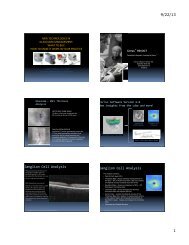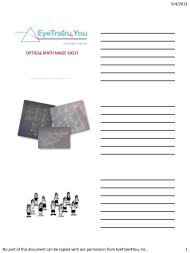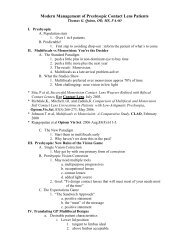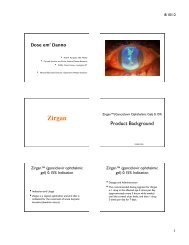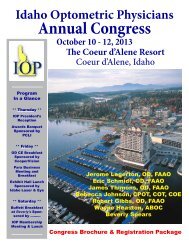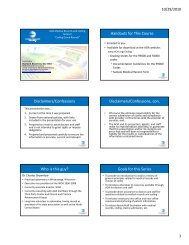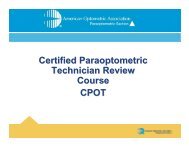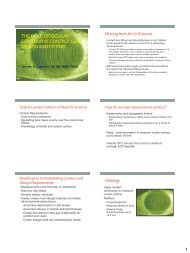Anterior Segment Disease
Anterior Segment Disease
Anterior Segment Disease
- No tags were found...
You also want an ePaper? Increase the reach of your titles
YUMPU automatically turns print PDFs into web optimized ePapers that Google loves.
9/17/13 Autologous Serum – The What For? Autologous Serum Studies l Severe Dry Eye l Alio – Ophthalmology 2007 l Corneal Ulcers (especially if dormant) l LASIK complications l Chronic Dystrophies (EBMD) l E-‐PRP improved symptoms – photophobia, pain, inflammation l E-‐PRP facilitated re-‐epithelialization l E-‐PRP promoted wound healing l Improved VA l “.. In the majority of the patients in the study.” Kojima study – Am J Ophthalmol, 2005 Autologous Serum What Does it Really Mean? l E-‐PRP for Dry Eye l Conclusion-‐ Autologous plasma is superior to conventional treatment for improving ocular surface health and subjective comfort l Autologous Serum brings growth factors directly to compromised eye. l <strong>Disease</strong>d eye is not getting nutrients to help healing l <strong>Disease</strong>d eye is undergoing chronic tissue breakdown l E-‐PRP breaks that cycle l E-‐PRP improved tear stability and vital staining scores (RB) Autologous Serum – Clinical Questions Tear Film Osmolarity l What is the dosage? l Where should it be kept? l When should it be Rx’d? l High tear film osmolarity (>308) is a leading indicator for dry eye l Changes in osmolarity precedes symptoms l May allow for earlier, more successful treatment l May allow doctors to monitor treatment success more quantifiably l Positive correlation between ocular surface condition and tear film osmolarity 2
9/17/13 So…. Tear Film Osmolarity Testing l If tear osmolarity high – Dry Eye l CPT code – 83861 l If tear osmolarity varies – mild to moderate Dry Eye -‐If tear osmolarity different between 2 eyes – mild to moderate Dry Eye l Reimbursement connotates that facility must have a moderate complex CLIA certificate -‐If osmolarity consistently low – not dry eye -‐ MGD or Allergy InflammaDry § Detects elevated levels of MMP-‐9 in tear fluid § 10 minute in-‐office results § Easy to use – can be performed by technicians or nurses § Disposable – no additional equipment required Limit of Detection: the normal level of MMP-‐9 in human tears ranges from 3-‐41 ng/ml §§Positive test result = MMP-‐9 ≥ 40 ng/ml Negative test result = MMP-‐9
9/17/13 MMP-‐9 and Dry Eye Severity 1 Patient’s Dysfunctional Tear Syndrome Level Average MMP-‐9 Level Normal (n=18) 8.39 ng/ml NO Severity Level 1 (n=15) 35.57 ng/ml NO Severity Level 2 (n=11) 66.17 ng/ml YES Severity Level 3 (n=9) 101.42 ng/ml YES Severity Level 4 (n=11) 381.24 ng/ml YES [1] Chotikavanich S, de Paiva CS, Li de Quan, et al. Invest Ophthalmol Vis Sci 2009; 50(7): 3203-‐3209. Statistical Significance vs Normal Positive Result = Chronic Dry Eye ≥ 40 ng/ml How to Use InflammaDry: Four-‐step Process 1. Gently dab the Sample Collector in 6-‐8 loca@ons on the palpebral conjunc@va (lower eyelid) to collect a tear sample. Do not use a dragging mo@on. 2. Snap the sample collector into the test cassette and press firmly where indicated. 3. Dip the test cassette into the provided buffer vial for 20 seconds. Replace the cap. 4. Read the results: 2 lines (1 red, 1 blue) = positive, 1 line (blue) = negative InflammaDry Clinical Trial Other Methods for Dry Eye Diagnosis 1 N = 206 Clinical Criteria + – Dry Eye Testing Method Sensitivity Specificity Schirmer Tear Test 42% 76% + 121 4 InflammaDry – 22 59 Sensitivity 85% (121/143) Specificity 94% (59/63) Overall Agreement 87% (180/206) Tear Break Up Time 92% 17% Corneal Staining 63% 89% Questionnaire 89% 72% TearLab Osmolarity 2,3 64-‐73% 71-‐92% InflammaDry Sensitivity 85% Specificity 94% [1] Versura P, Frigato M, Cellini M, et al. Diagnostic performance of tear function tests in Sjogren's syndrome patients. Eye (Lond). 2007;21:229-‐37. [2] TearLab Performance Data – 510(k) Clearance. [3] Lemp MA, Bron AJ, Baudouin C, et al. Tear osmolarity in the diagnosis and management of dry eye disease. Am J Ophthalmol 2011;151:792-‐798. TreatmentTreatment of of Dry Dry Eye Eye § Elevated MMP-‐9 may predict which patients will respond to anti-inflammatory therapy § Patients who test positive can be treated with one of the following: 1-‐3 − Cyclosporine, Steroid, or Doxycycline [1] De Paiva CS, Corrales RM, Villarreal AL, et al. Exp Eye Res 2006; 83(3): 526-‐535. [2] Gurdal C, Genc I, Sarac O, et al. Current Eye Research 2010; 35(9): 771-‐777. [3] Li DQ, Zhou N, Zhang L, et al. Invest Ophthalmol Vis Sci 2010; 51(11): 5623-‐5629. Cyclosporine and MMP-‐9 MMP-‐9 expression was evaluated by immuno-histochemistry. The mean percentage of MMP-‐9 expression of the conjunctival epithelial cells was significantly decreased. MMP-‐9 expression was evaluated semi-quantitatively by measuring cytoplasmic staining for MMP-‐9. 60 50 40 30 20 10 0 Baseline [1] Gürdal C, Saraç O, Genç, et al. Ocular surface and dry eye in Graves' disease. Curr Eye Res 2011; 36: 8-‐13. MMP-‐9 Activity Two Months After Cyclosporine Treatment N=24 eyes of patients with thyroid orbitopathy-‐related dry eye 5
9/17/13 Corneal Collagen Cross-‐Linking CCXL-‐ How It Works l Clinical Indications l Keratoconus l Forme-‐fruste keratoconus l Post-‐LASIK ectasia l Post-‐RK l Pelliucid Marginal Degeneration l Cornea is saturated with riboflavin l Cornea is exposed to UV light l Photosensitization occurs, singlet oxygen released l The molecular oxygen causes extra cross-‐linking of corneal collagen fibers and extracelluilar matrix proteins l This causes corneal stiffening CCXL – The Procedure CCXL Post –op Process l Debridement of central 7-‐9mm of epithelium l Riboflavin 0.1% is applied and allowed to saturate cornea for 30 minutes l Cornea is irradiated with 370-‐nm wavelength light for 30 minutes, riboflavin is reapplied every 5 minutes throughout the procedure l Topical antibiotic ointment and bandage CL applied l Monitor post-‐op healing closely l Much like PRK post-‐op l Watch for infection – antibiotic l Mitigate corneal haze – steroid l Moderate pain-‐ NSAID l Final result may not be seen until 18 months out, so refraction may vary Some CCXL Particulars CCXL Benefits l Cornea must be saturated before UV light application l 90% of the UV light absorbed within the anterior 400 microns of K l Riboflavin blocks deeper light penetration thus avoiding cytotoxicity at endothelium or lens capsule l Effect is not immediate, 3-‐6 months for new keratocytes to repopulate and remodel cornea l Improvement continues over 15 month period l Improved regularity to corneal shape l Decreased apical scarring l Improved UCVA and BCVA l Decreased astigmatism l Improved ability to wear CL l Improve outcomes with secondary ICCL l CCXL definitely works better on early diagnosed keratoconic pxs! 6
9/17/13 56 yr old male with Keratoconus: Epi-‐On CXL OS Pre Op 6 months Post Op UCVA CF 100 BSCVA 25 20 Refrac@on -‐7.75+0.75x150 -‐3.75 +1.50 x 180 58 yr old female with Keratoconus: Epi-‐On CXL OD OD Pre Op 12 months Post Op UCVA CF 20/200 BSCVA 20/400 20/50 Refrac@on -‐10.25+5.25 x 175 -‐10.00+2.50x175 6 months Preop Difference Map William Trattler, MD case Preop 12 months Difference Map Cliff Salinger & William Trattler,MDEpi-‐On Crosslinking for Ectasia 38 year-‐old male with post-‐Lasik ectasia CCXL ADVERSE EFFECTS OD UCVA Refraction BSCVA Pre Op 200 -‐3.50+6.50x180 30 3 Months 50 -‐0.75+1.75x175 25 l Treatment failure l Risk factors for treatment failure are: l Age 35 or older l BCVA 20/25 or better l K reading > 58.00D l Post-‐op infection l Stromal haze l Increased IOP Post Op 3 Months Pre Op Difference Map CCXL – 2 years later Summary of Epi-‐ON l Epi-‐On can be as effective as Epi-‐Off l Technique differences can explain differences in results l Age is not a major factor l Older patients can benefit from crosslinking l EPI-‐On CXL l Benefits: l Faster visual recovery/less pain l Reduced risk of pain/haze l Very good clinical results l Even in keratoconus patients in their 50’s and 60’s l Progression is not required for successful results with crosslinking l Non-‐progressive patients can achieve improvement in corneal shape, UCVA, and BSCVA l Downside: l Longer procedure (30-‐50 min longer) l Can not combine with simultaneous topo-‐guided PRK 7
9/17/13 The future for Collagen Cross-‐Linking Pre-‐Medicated Punctal Plugs l Treatment of recalcitrant bacterial corneal ulcers l Esp if in anterior 250 microns l Corneal melts l EBMD l As an adjunct to Orthokeratology!! l Antibiotic containing intracanalicular punctal plug l Used for sustained drug release l Safety and feasibility was demonstrated l 95% retention rate through day 10 Moxifloxacin Punctum Plug (Ocular Therapeutix) Safety and Feasibility Studies l Polyethylene glycol plug – dissolvable l Moxifloxacin-‐encapsulated microspheres l Study 1 – l 90% Retention rate through Day 10 l All plugs absent by Day 30 l Dimensions that swell or shrink to conform to punctum l 2 Phase I Prospective Single Arm Studies l Implanted at cataract surgery l Followed for 30 days post-‐operatively l Study 2 – l Adjusted study for more stringent tear sample collection l Higher levels of available moxi were found l 100% retention rate at Day 10 Study Goals Is this clinically significant? l Reaching therapeutic level of moxifloxacin in tears l Drug levels were well above MIC-‐90 levels needed for staph aureus, staph epi., strep pneumoniae l Safety l No adverse effects l Overall ease of use noted l Specifically did not look at clinical outcomes l Therapeutic success has not been proven , but if that can be shown then… l Much more than just post-‐op therapy opens up l Corneal ulcers l Uveitis l 30 day implant for glaucoma l Allergic eye disease 8
9/17/13 Novel Drug Delivery Systems-‐ the next frontier Intravitreal/Intracameral Injections l Drug Eluting Punctal Plugs l QLT – latanoprost l 75% -‐80% retention rate l Results-‐ 3-‐4mm drop in IOP l Ocular Therapeutix – Intracanalicular latanoprost l Good sustained release of drug but doesn’t lower IOP as good as topical Xalatan l SOOOO???? l Intracameral seems to be preferred l Less likely to stay on cornea l Most of drug stays in AC l Little is transferred to vitreous l Brimonidine DDS (Biodegradable Drug Delivery System) l Polymer breaks down into H2O and CO2 l Duration and effect are in question Implantable Devices for Glaucoma Transdermal Testosterone Therapy l 27 g needle used to place implant intracamerally (either in front of or posterior to iris) l 5% transdermal testosterone cream l PLGA polymer used l Different implants allow the concentration and delivery rate of drug to be altered l Lasts up to 6 months l Great for compliance, ?? IOP drop l Applied to eyelid BID l Increases tear production l Consequences for optometry l Increases meibomian gland secretion Transdermal testosterone Transdermal testosterone l Clinical Indications l Connor study – ARVO 2010 l Dry Eye l CL intolerance l Chronic surface disorders l Exceptional effective on females l TFBUT increased from 2.6 to 6.5 seconds l Average CL wear time increased from 1 hour to 10.5 hours l All patients were female, 80% post-‐menopausal 9
9/17/13 Anti-‐ VEGF Therapy VEGF is found in great concentrations l Vascular Endothelial Growth Factor (VEGF) promotes angiogenesis l Increases venous permeability l Induces vascular endothelial cell mitosis and migration l Corneal epi-‐ and endothelium l Limbal vessels l Scar tissue l Choroid l Ciliary Body l So Anti-‐VEGF therapy should affect these tissues Topical anti-‐VEGF therapies Lipi View and Lipi Flow l Bevacizumab, ranbizumab and sunitunib have all been investigated for topical treatment of l Diabetic macular edema l Corneal neovascularization l CNVM l Results? l Potential? 10



